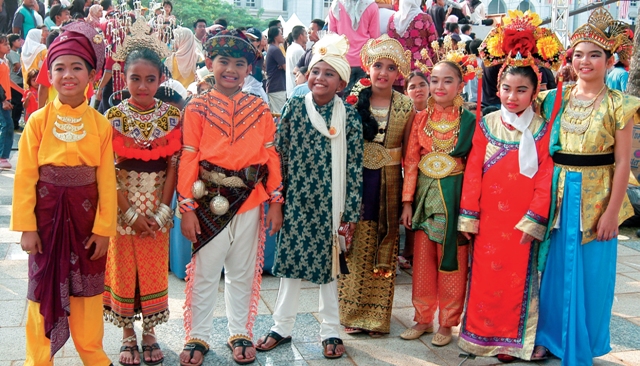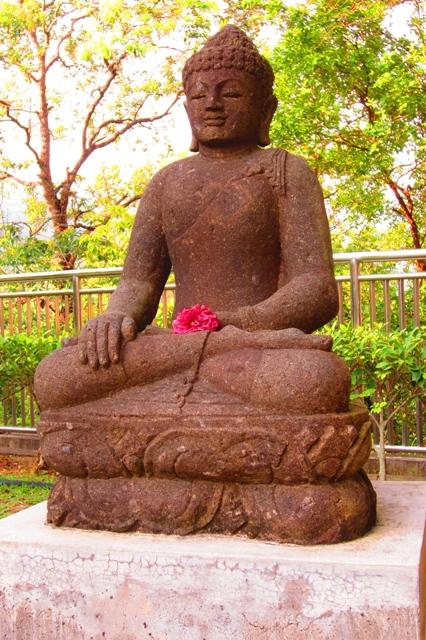
This post was written by Kat Fatland
One of Malaysia’s many unique characteristics is the intriguing mixture of religions that live side by side, despite the country often being identified as Islamic. Kat Fatland tries to understand more about her new home by exploring the history of the three dominant religions and what brought them here.
When visitors first arrive in a foreign country, the culture can seem both literally and figuratively incomprehensible. Those arriving are met with an overwhelming array of unfamiliar traditions, languages, ways of life, and societal norms, all of which come together to create a wonderful, chaotic, and rewarding sensory experience.
By putting our senses to good use, we begin to piece together the unfamiliar aspects surrounding us and create for ourselves a rudimentary understanding of what a place is like. As soon as I entered Malaysia, I began to understand it through the taste of its delectable street food, the sounds of its many calls to prayer, and its intricately decorated temples celebrating a multiplicity of religious traditions. But underneath the plates of char kuay teow and the smell of burning joss sticks I’ve come to define as distinctly Malaysian, there exists a deeper layer of cultural understanding that is often more difficult to grasp. This understanding requires those curious to move off the street and into the library.
One of Malaysia’s most wonderful aspects is the diversity of its inhabitants. Comprising ethnic Malays, Chinese, and Indians as well as a myriad of other minorities, the country is distinctly multicultural. Each of the different cultures stems from equally diverse religious traditions. Daily sounds of the mosque are blended with smells of slowly-burning incense; women in saris walk next to women wearing the hajib; storefronts display wooden carvings of Ganesh next to carvings of the Buddha. By studying these traditions, our daily sensory experiences become part of a broader cultural context, which in turn enriches our everyday lives as tourists, expats, and interested citizens of the world.
I recently endeavored to get to know three of the country’s main religious traditions better and, as it turned out, the question of what these religions stand for, how they got here, and how they are practiced proved a fascinating one to answer.
Islam
According to the 2010 Population and Housing Census, 61.3% of the country’s population identify with Islam, the country’s official religion. This percentage is overwhelmingly made up of ethnic Malays. The only form of Islam that is practiced in Malaysia is known as Islam Hadhari, which encourages an open mind, tolerance, inclusivity, honesty, and hard work. This moderate version of Islam is the end result of centuries of Islamic influence on the peninsula, which arrived over 1,300 years ago.
Arab traders sailed to the Malay archipelago as early as the seventh century, but it was perhaps not until the 12th century that the religion began to make waves. In 1136, Kedah, now Malaysia’s northernmost state, transformed into the peninsula’s first sultanate when King Phra Ong Mahawangsa, a Hindu, decided to convert to Islam, changing his name to Sultan Mudzafar Shah. During this time, north Indian traders, who were themselves newly converted to Islam, began to arrive on the island, aiding the religion’s growth.
Just under 300 years later in 1400, the Malacca sultanate emerged under Sultan Iskandar Shah. The sultanate’s comparative wealth and power as a regional entrepôt allowed it to become a center for Islamic learning. Slowly, the modern Malay-Islamic identity began to form and spread across the greater region. By the end of the 15th century, Islam was the dominant religion of the Peninsula.
Communities typically integrated Islam into their already-formed spiritual belief systems, which usually included animism. Even today, in smaller Malay villages, Islam is practiced syncretically with other systems of belief, although the majority of the country has since become more uniform in its practice of the faith. Each community in Malaysia has its own mosque, which gives the calls to prayer each day. The primary purpose of the calls themselves, formally known as adhan, is to provide each community with a basic summary of the Islamic faith. There are different calls to prayer according to which sect of Islam participants adhere to: in Malaysia, only the Sunni call to prayer is used.
Buddhism

Roughly 20% of the population identify as Buddhist, making the religion the second largest in the country. Because this religion does not identify with any god-like figure, it can blend easily into other cultural and spiritual traditions of a community. Thus in Malaysia, Buddhism was historically practiced alongside Hinduism, and is still today often practiced in tandem with other Chinese traditions. Many modern Buddhist temples contain Taoist dieties and depictions of folk Chinese saints.
From the first century onwards, India exerted a strong influence in all of Southeast Asia, including Malaysia. Indian traders and priests brought with them both Hinduism and Buddhism. At this time, India widely identified with the Mahayana, or “great vehicle” branch, of Buddhism.
The core belief of all Buddhist traditions is that Nirvana, or release from the suffering of life, is attainable through a series of mindful practices. Individuals are continually reborn until they attain Nirvana. But because Nirvana is so difficult to obtain, the Mahayana sect believes there are Bodhisattvas, or mentors, who attained Nirvana quickly but chose to be reborn in order to help others live more mindful lives. The inclusive nature of the Bodhisattva adds to Mahayana’s ability to blend seamlessly into other religious traditions, which it did throughout the first millennium. Tibetan Buddhists, a subsect of Mahayana Buddhism, believe the Dalai Lama to be a reincarnation of the Bodhisattva of compassion.
Mahayana was eventually replaced in Southeast Asia by Theravada Buddhism, who believe the monastic life to be the superior path to take. This is the reason travellers might see more monks in Thailand and Cambodia: these two countries practice Theraveda, whereas Malaysia continues to practice Mahayana.
Hinduism
Hinduism makes up a comparatively smaller percentage of Malaysians, with only 6.3% of the country identifying as Hindu. The religion is practiced in a variety of different forms across the globe, but the majority of Malaysian Hindus follow the Shaivite tradition common in southern India. This tradition gives precedence to the god Shiva, the god known as “the Destroyer” and typically depicted as holding a trident. Followers of Shaivism are often marked with “sacred ash,” a white ash placed on believer’s foreheads to denote reverence.
Although Hinduism was brought along with Buddhism to Malaysia in the first century and was practiced widely prior to the spread of Islam, most of religion’s current adherents are descended from Indian migrant workers from Tamil Nadu, south India, who came to the region to work on British rubber plantations.
The Hindu religion is deeply diverse, with belief systems within ranging from polytheistic to atheistic and can hardly be generalized. But Shaivism, one of the four main Hindu denominations, resembles a monotheistic tradition in that its adherents believe Shiva is the Supreme Being, with other numerous divine beings subordinate to him. Many think Hinduism is always polytheistic, but many of the god-like incarnations seen in the temples are in fact either devas, benevolent supernatural beings, or avatars of the Supreme Being himself.
Spending time in Malaysia, with these and other religions and belief systems embraced on both the Peninsula and in East Malaysia, one could get a spiritual education comprising Eastern, Western, and indigineous religions. Truly, Malaysia is a land of many faiths.
———————————————————————————————————
Source: Senses of Malaysia Jul-Aug 2013
What are your thoughts on this article? Let us know by commenting below.No registration needed.
"ExpatGo welcomes and encourages comments, input, and divergent opinions. However, we kindly request that you use suitable language in your comments, and refrain from any sort of personal attack, hate speech, or disparaging rhetoric. Comments not in line with this are subject to removal from the site. "

















Great <3